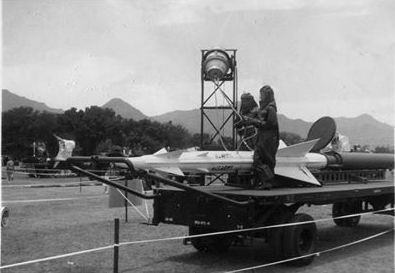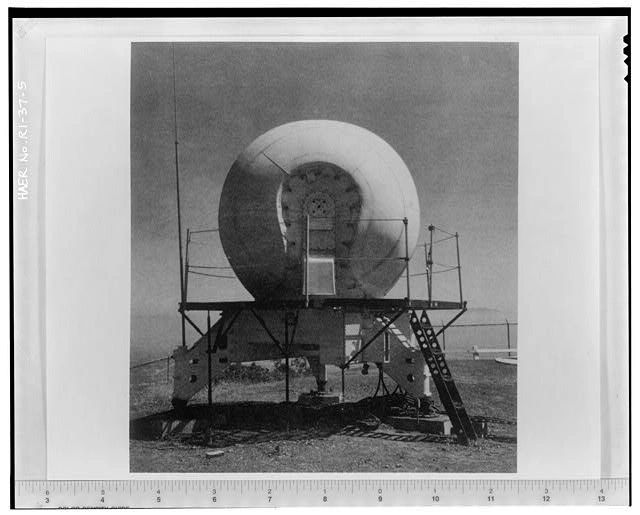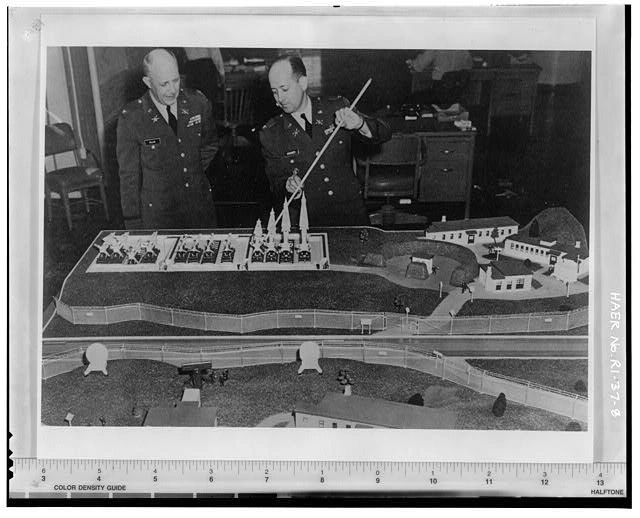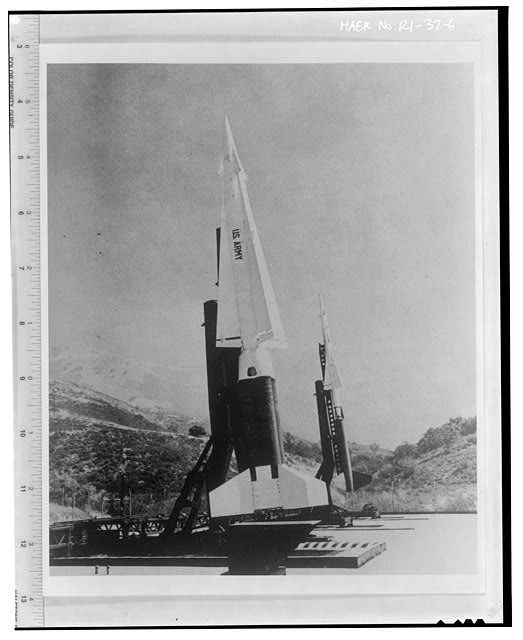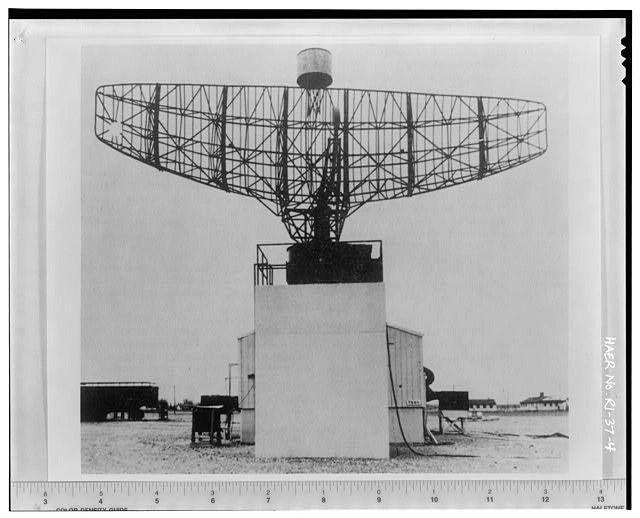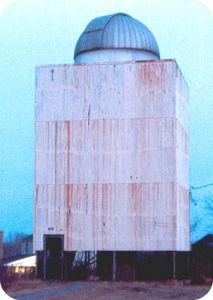Nike Sites of CT
Atomic Bombs in the Backyard
While it is well known that Connecticut was home to a number of Nike Missile sites back in the fifties and sixties (12 to be exact), very few people realized that by the early-sixties some of these sites housed missiles with nuclear warheads on them!
The original Nike missile, the Ajax, used a high explosive fragmentation warhead that could successfully destroy or at least damage a single incoming Russian bomber. As Soviet bomber production increased the one missile/one bomber scheme was deemed impractical so the decision was made to equip some of the second generation Nike missiles, the Hercules, with atomic warheads in the 1-40 kiloton range (in comparison, the nuclear bomb which destroyed Hiroshima was approx. 15 kiloton). The atomic warhead would be detonated in front of an incoming group of bombers and would in theory destroy or damage them by either the blast or by the radiation effects including thermal and EMP. Having nukes go off above the continental US was thought to be much more desirable than having them go in our cities!
Each Nike site actually consisted of two facilities, a control or radar site known as an "IFC" most often located on a hill for maximum line of sight range and a companion launch site also known as a "battery" which was usually within two miles of the control site. There were also Nike housing units assigned to most batteries and a regional maintenance center in Windsor Locks, CT.
Each of the individual CT Nike sites has its own page, see menu at the top of the page.
Massachusetts Nike sites can be seen in our companion site:
http://coldwar-ma.com
If you were stationed at one of the many Nike sites in CT, MA or RI we would love to hear from you. Please contact us at webmaster@coldwar-ct.com
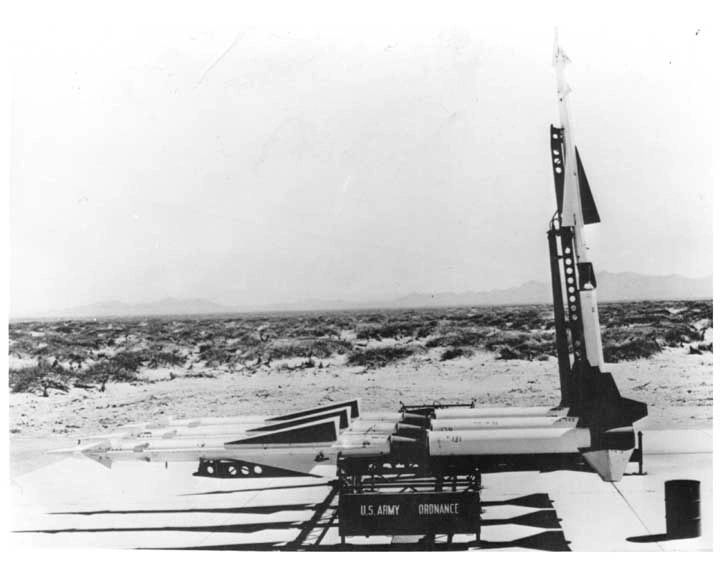
Nike Ajax missiles.
Each of these Hartford Area Nike Sites have dedicated pages above:
HA-08 E. Windsor/Warehouse Point. The control site was on Scantic Rd, present site of the New Testament Church. The launch site was on Phelps Rd at what is now the Army Reserve Center.
HA-25 Manchester. The control site was at 110 Garden Grove Rd currently used by the Town of Manchester. Nike Tykes Daycare occupies one of the building, a private shooting range occupies the former military indoor range.
The Launch site was on Line Street. The property is currently owned by CL&P, the local utility. The structure have collapsed and the silos filled in.
The old Nike housing area is most likely occupied on Faith Circle (Rainbow Condominiums) off of Hercules Rd.
HA-36 Portland,
The control site was on Reeves Rd in the Meshomasic State Forest. Structure foundations remain.
The launch site was on Clark Hill Road. Foundations remain and the silos have been filled in.
HA-48 Cromwell. The control site was on Country Squire Rd, currently the site of elderly housing.
The launch site was in Middletown on Mile Lane, currently an Army Reserve center.
HA-HQ New Britain Rocky Hill Road.
HA-67 Plainville.
The control site was on North Mountain Rd off Loon Lake.
The launch site was on Hyde Rd off Scott Swamp Road, current site of Stanley Works, Magic Door Division.
HA-85 Avon/Simsbury.
The control site was 824 Montevideo Rd, current location of the Talcott Mountain Science Center.
Each of these Bridgeport Area Nike Sites have dedicated pages above.
BR-04 Ansonia. The control site is currently being used by the US Forest Service Insect and Disease lab.
http://tony6905.smugmug.com/Military/Ansonia-Niki-Site-Active-Army/3789948_HRDcM#218604147_j48sh
The Launch site was on Osborne Land and Deerfield, currently the site of Copper Ridge Farm. Assembly building is still standing. THe launch magazines have been filled in.
BR-15 West Haven The control site was on March Hill and is presently used by the Orange Air National Guard and the USAF.
The IFC site is intact and presently being used by the CT Air National Guard and an Aircraft Control and Warning site.
Bull Hill Lane in West Haven, currently owned by the Parks and Rec Dept's Nike Site Park.
BR- 17 Milford The control site was at Eels Hill Rd, north of Rt 162. It is currently used by the town of Millford and an amateur radio club.
The Launch site is located south of Rock Rd near Quirk Industrial Park. Residential houses and a ball park now occupy the site.
BR-65 Fairfield The control site was located on One Rod Highway off of Reef Rd and is currently being used as a fire training center by the Town of Fairfield.
The launch site was on Old Dam Rd, off Pine Dreek, the present site of South Pine Creek Park.
There was also an administrative area.
BR-73 Westport The control site was on Bayberry Ln at the Merritt Parkway, presently the Westport/Weston Health District Office and the Westport Astronomical Society.
The launch site is a 85 North Ave and is used as a firefighter training center.
BR-94 Monroe The control site was on Eagle Drive extension, presently a US Gov't storage facility.
The Launch site was at 41-14-28, 72-10-21.
There was a separate housing area.
Nike System Overview:
Cold War Air Defense and Creation of the Nike System:
For the first years of the Cold War, the US had a monopoly on atomic weapons and theirdelivery platform, the B-29 long-range strategic bomber. The monopoly ended when theSoviets used reverse engineering to build their own version of the B-29. The first TU-4 wasunveiled in 1947. In 1949, the Soviet Union tested its first atomic weapon. Americans werepainfully aware after the Japanese attack on Pearl Harbor that the measure of securityafforded by geographic separation from Europe and Asia was waning, but Hawaii was stilla significant distance from the American mainland. The Soviet development of the TU-4and their possession of nuclear weapons removed that remaining sense of security, becauseit meant for the first time that an adversary could decimate America’s largest cities fromabove.US decision-makers and military planners developed a two-part strategy for countering thethreat from the Soviet Union. The first part of the strategy was called deterrence. Under thisstrategic concept, the military worked to deter the Soviet Union from an attack on the US orits allies with the threat of massive atomic retaliation designed to destroy the enemy’s ability and willingness to make war. If the deterrence strategy failed, the military madeplans and developed weaponry designed to minimize the destruction caused by an attack.The US Air Force held the primary responsibility for defending the nation from an airattack. Air Force planners developed a “defense-in-depth strategy that encompassed earlywarning radars, fighter aircraft, and long-range anti-aircraft missiles positioned to detectand engage the enemy before they entered American airspace.” Because its weapons hadgreater range and were able to protect a larger area, the Air Force was charged with the areadefense portion of “defense-in-depth.”
The US Army had shorter range weapons thatprovided close protection of strategic sites. The Army’s anti-aircraft artillery batteries weretherefore considered point defense weaponry. The “defense-in-depth” design created twotiers of protection for strategic sites. If an enemy was able to breach the outer or areadefense tier provided by the Air Force, the attacker still had to deal with the inner or pointdefense tier provided by the Army. Planning for a missile-based antiaircraft system began during the last months of World WarII, when the US Military realized that conventional antiaircraft artillery could not deal withthe fast, high-flying and maneuverable jet aircraft and rockets being introduced by theGermans. The development of short-range antiaircraft missiles fell to the US Army, as anatural evolution of the point defense they had historically provided with antiaircraftartillery.
After observing the effects of the Nazi V-1 and V-2 rocket attacks on London, US ArmyLieutenant Jacob W. Schaefer, a former employee of Bell Telephone Laboratories,proposed the development of a radio-controlled antiaircraft rocket that could be used toprotect strategic sites from bomber attack. His proposal called for “command guidance”that would use multiple radars to direct a missile to an incoming target.In June 1945, Army contractor Western Electric and its research and development arm, BellLaboratories, began development of the new system. Western Electric selected DouglasAircraft Company as the major subcontractor to design and manufacture the missile,booster, and launching equipment. The US Army initially called the new weapon the AntiAircraft Guided Missile (AAGM).Later, Colonel Gervaise Trichel, head of US Army advance research and a classical scholar,named the new missile Nike for the Greek goddess of victory. The first generation of theNike missile was called the Nike Ajax. When it was deployed in 1954, it was “the world’s first operational guided, surface-to-air missile system.”
It could reach an altitude of 70,000 feet, and had a top speed of Mach 2.3 (1,679 miles per hour [mph]). Nike missiles were guided by a computer in the Integrated Firing Control (IFC) area from the time they were launched until they were detonated by a signal from the IFC. A Nike battery was activated when the acquisition radar detected a target and verified that it was hostile. The Target Tracking Radar (TTR) would then lock onto and track the hostile target. A third radar, the Missile Tracking Radar (MTR), was then aimed at an individual Nike missile located at the nearby Launcher Area. Both the TTR and MTR were linked to a guidance computer located within the Battery Control Trailer at the IFC Area. The missile was launched and sent on its supersonic path to intercept the hostile target. The MTR relayed steering commands from the guidance computer to guide the missile toward the target. At the moment of closest approach, the missile’s three warheads would be detonated by a computer generated “burst command” sent from the ground via the MTR.
Typical Nike Ajax Missile Installation
In the early 1950s, tensions between the US and the Soviet Union were increasing. The Army felt an urgent need to field the Nike Ajax throughout the country as quickly as possible, especially after the delays with the development of the missile. Army planners initially considered using prefabricated buildings, but ultimately decided to use standardized, “modified emergency” designs that were more permanent. These buildings were typically one to two stories in height, and featured concrete block walls with flat metalroofs. This utilitarian, industrial design is considered Military Vernacular architecture. The style is characterized by the lack of high-style design influences, as the standardized plans were intended to be purely functional and adaptable to local conditions. A typical Nike Ajax missile installation consisted of three distinct areas: the administrativearea, the Integrated Fire Control Area, and the Launcher Area. The administrative area was often built on an adjacent parcel of land to the IFC or the launch area. A typical administrative area featured the following buildings: a barracks, a sentry guardhouse, an administration building, a paint/oil shed, a water treatment plant, a mess hall, arecreation/administration supply building, and a separate area with single-story detached homes for married personnel and their families. The design of the missile system required the IFC and the Launcher Area to be separated by at least 1,000 yards, but no more than three miles. To launch a missile, the radar equipment needed a direct line of sight between the IFC and the Launcher Area.
Deployment of Nike
In March 1954, the first Nike Ajax unit deployed to an above ground site at Fort Meade,Maryland. On May 30, 1954, it became fully operational on an around-the-clock, combat ready status. By 1958, the US Army had deployed nearly 200 Nike Ajax batteries aroundthe nation’s cities and vital military installations. Each defense area consisted of a number of missile batteries grouped around the identified targets to be protected.
Maintenance of Nike Missile Systems
The test equipment used to support the Nike batteries was identified by two major areas of use. One group was the missile test equipment which was used to test, troubleshoot, and repair the missile and launching equipment. The other group which was used to test, troubleshoot, and repair assemblies from equipment in the radar course directing central. The equipment in both groups was used by direct support, general support, and depot maintenance personnel to keep the Nike batteries in a combat ready status. Operational field maintenance occurred either on-site from specially designed trailers containing test equipment or at specialized Tactical Site Support Facilities that performed maintenance on missiles and support equipment that was beyond the capability or equipment of the battery. The permanent facility was constructed in a centralized area to serve all the batteries within a particular defense area. At the support facility, missiles were inspected, and radar navigation instrumentation were calibrated. These support facilities typically had an engine test cell, consisting of a reinforced-concrete wall and a ceiling strengthened with 4-inch steel pipes and a woven steel cable blast mat.
Deactivation of Nike Missile Systems
Ultimately, the Nike Ajax missile system had a short service life in the continental United States. The first Ajax unit deployed to Fort Meade, Maryland in March 1954. By June 1958, the Army had begun the process of adapting existing Nike Ajax batteries to support a second generation surface-to-air missile, the Nike Hercules.
During testing of the Ajax missile, the Army became concerned about the missile’s ability to defend strategic sites in the event of a massed Soviet bomber attack. It was not considered feasible at the time to add a nuclear warhead to the Ajax missile, so the Army authorized the development of the nuclear-capable Nike Hercules. In addition to carrying a nuclear payload that the engineers believed could destroy a Soviet bomber squadron, the Nike Hercules had an increased range of 75 miles. This was nearly triple the range of the Nike Ajax. As a result of this increased range and firepower, fewerNike Hercules batteries were required to protect the strategic areas than the Nike Ajax. Ironically, the idea of use of a nuclear weapon over large population areas (and associated fallout effects) to block incoming Soviet bombers with nuclear payloads for the target population areas is not generally discussed in the decision to upgrade to a nuclear payloadon the Nike system.The Army ultimately built 35 new Nike Hercules batteries, and adapted 110 existing Nike Ajax batteries to accommodate the Nike Hercules. The remaining Nike Ajax batteries were subsequently deactivated. The Army defended the nation’s strategic sites with the Nike Hercules until the mid-1970s. By that time, it had become clear that the Soviets would bemore likely to attack the US with ICBMs than with massed bomber squadrons. In the technological race that characterized the Cold War, the military had to move beyond traditional surface-air-missiles to develop an ABM system that would address the newer ICBM threat.State and Local Context Nike Batteries in Connecticut
Within the state of Connecticut, two Nike defended regions were established. One defended area was centered on the important manufacturing city of Bridgeport. The other protected the Greater Hartford area. Each defended area contained six Nike missile batteries which became operational 1956 -1957. Each of the twelve missile installations was initially manned by Regular Army units. However, within a few years, the Connecticut Army National Guard became an important participant within the Nike program, manning several sites within the Bridgeport and Hartford regions. Connecticut's Nike missile batteries were initially equipped with the first-generation Nike missile, the Nike Ajax. Beginning in the late 1950s, three of the sites were upgraded toutilize an improved, second-generation Nike Hercules. Two of the upgraded missile sites were located within the Hartford region, at East Windsor and Cromwell. The third was located at Ansonia, north of Bridgeport.
The Hartford Defense Area
Six Nike missile batteries were constructed within the Greater Hartford Connecticut region. Becoming operational during 1956 the sites were designed to encircle the region with overlapping fields of guided missile fire. The Hartford area Nike sites and dates of operation:• HA-08 East Windsor (1956-1971)• HA-25 Manchester (1956-1961)• HA-36 Portland (1956-1963)• HA-48 Cromwell (1956-1968)• HA-67 Plainville (1956-1961)• HA-85 Avon/Simsbury (1956-1963). All of the sites were roughly similar in specification, utilizing the Nike Ajax missile system and having three underground missile storage magazines. Most sites were equipped with 30 missiles. Each of the Nike Defense Areas that ringed New England cities also included a maintenance and equipment testing shop where the Nike missiles were maintained and repaired and where radio navigation instruments were calibrated and tested.
Windsor Locks Nike Field Maintenance Shop/USAR AMSA
The simple, functional mid-century modern building types found at the Nike missilecontrol, launch, and maintenance facilities were designed by three firms: Leon Chatelaine,Jr., of Washington, D.C.; Spector and Montgomery, of Falls Church, Virginia; and Ganteaume and McMullen, of Boston, Massachusetts. Windsor Locks was constructed from the standardized plans developed by the firm.The headquarters for the Army's 63rd Artillery Group which controlled the Nike battalions was located at New Britain. A Tactical Site Support Facility Maintenance Shop was constructed in Windsor Locks to support the Hartford Defense Area batteries. The maintenance shop performed maintenance on missiles and support equipment that was beyond the capability or equipment of the battery. Missiles were inspected, repaired,painted and radar navigation instrumentation was tested and calibrated. The facility also had an engine test cell, consisting of a 32-foot-by-13-foot room with 1-foot-thick reinforced-concrete walls, and a ceiling strengthened with 4-inch steel pipes and a woven steel cable blast mat. All of the Hartford area sites were initially manned by Regular Army units assigned to the U.S. Army's Air Defense Command (ARADCOM). Units from the adjacent Bridgeport Defense Area contributed to the manning of the Plainville installation. Later, units of the Connecticut Army National Guard began air defense operations at select sites under a nationwide scheme to incorporate reserve elements into the nation's air defenses. The headquarters for the National Guard Nike units was located in West Hartford. Due to the enhanced nuclear capabilities of the Nike Hercules system, fewer missile sites were needed to defend the Hartford region. Accordingly, only two missile sites - the East Windsor and Cromwell installations - were upgraded to utilize the Army's new Nike Hercules missile system. Site inactivation within the Hartford area began during 1961 when the missile installations at Manchester and Plainville were closed. The two National Guard operated Nike Ajax sites at Portland and Avon/Simsbury were inactivated just two years later. By 1964 only two Nike Hercules equipped sites remained operational. Of these two, the Cromwell Nike installation remained operational through the autumn of 1968. It had been manned by the Connecticut Army National Guard over the final four years of its operation.The last operational Nike missile site in the Hartford region was the East Windsor site. It remained in active service (under the Connecticut Army National Guard) until the summer of 1971. During June of that year, the East Windsor site and the Windsor Locks Tactical Site Support Facility Maintenance Shop, along with the Nike site in the Bridgeport region (Ansonia) were inactivated, marking the end of the Nike air defense in Connecticut. The transition from the conventionally-armed Nike Ajax surface-to-air missile to the nuclear-tipped Nike Hercules missile that began in the early 1960s resulted in the decommissioning of a number of New England Nike missile control, launch, and maintenance facilities. Six former Nike facilities were transferred to the Army Reserve in the late 1960s and early 1970s. Three sites, East Windsor and Middletown, Connecticut and
Windsor Locks Nike Field Maintenance Shop/USAR AMSA Danvers, Massachusetts, were large parcels formerly occupied by Nike control or launch facilities.The Nike sites were converted to Army Reserve centers, with varying degrees of retention of original Nike buildings. Three more former regional Nike missile repair facilities atMilford and Windsor Locks, Connecticut and Lincoln, Rhode Island made ideal conversions to Area Maintenance Support Activity (AMSA) facilities, which were being developed at that time to allow th e Army Reserve to maintain their own vehicles. Windsor Locks was converted to an USAR AMSA in 1971.Windsor Locks and the USAR Era (1971-2011) As an AMSA shop, Windsor Locks served units in northern Connecticut and central and western Massachusetts as a motor vehicle heavy maintenance and repair garage for assigned USAR unit vehicles in the region for four decades. AMSA personnel performed major tasks such as engine rebuilding, transmission and axle replacement, painting, andmajor repairs, including wreck damage. The AMSA was also a storage location for USAR vehicles such as tanker trucks and earth moving equipment, which were too large for permanent storage at their assigned USAR centers. The facility was closed 15 September2011 under the Base Realignment and Closure Act of 2005.


Cut-away view of typical Nike underground launch battery.

Interior view of underground launch battery showing the elevator used to
lift missiles to the survace for firing in the up position.


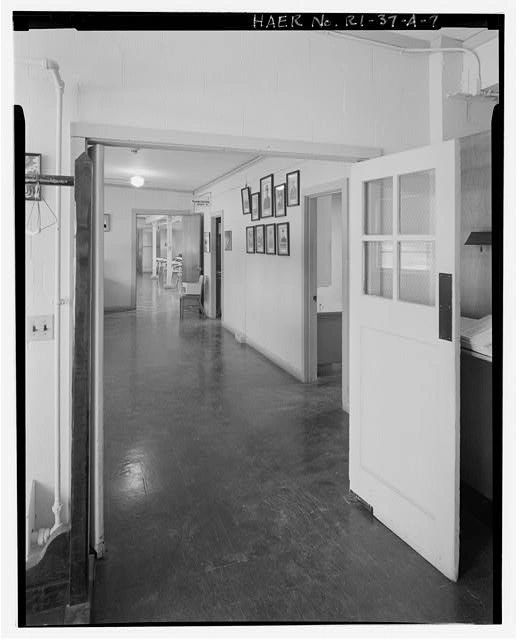

Typical Nike barracks.

Nike Hercules missile on transporter.



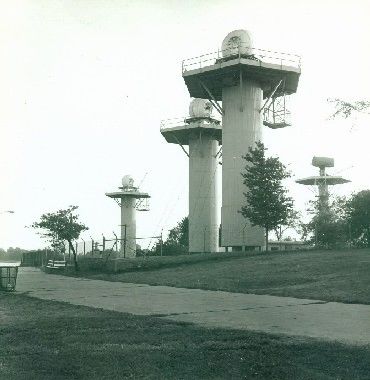
Radars atop pedistals.




Typical I.F.C. installation.
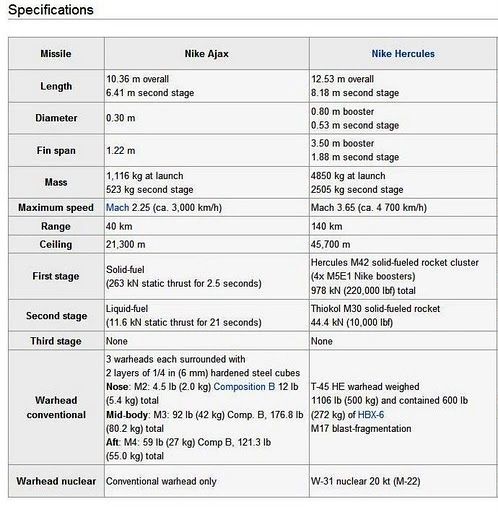
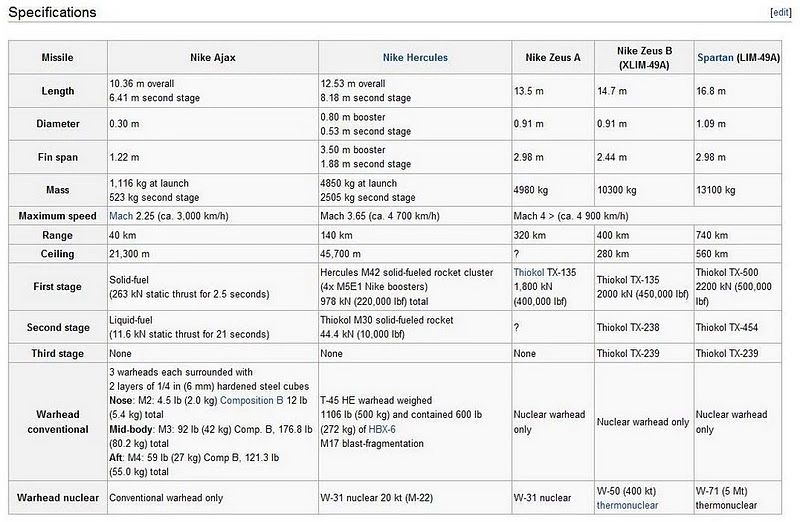





\
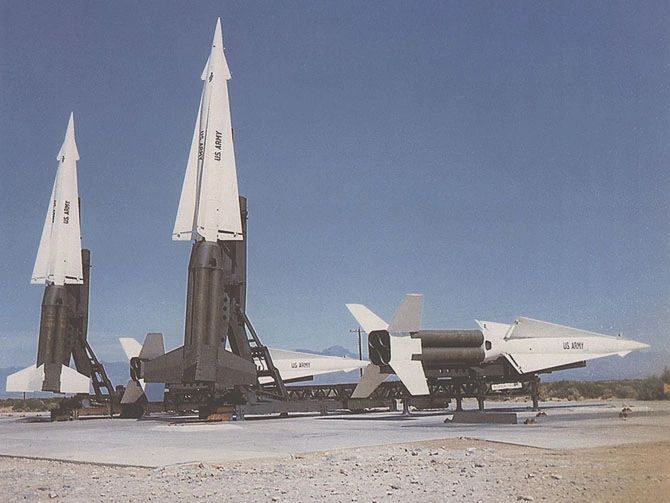
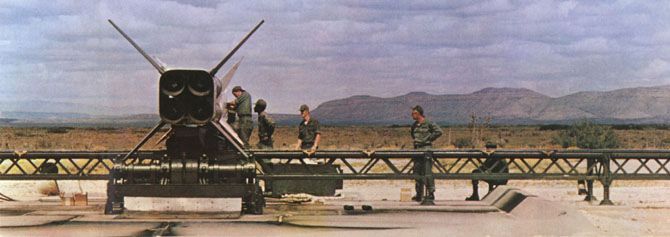
Hercules missile on the "rails".


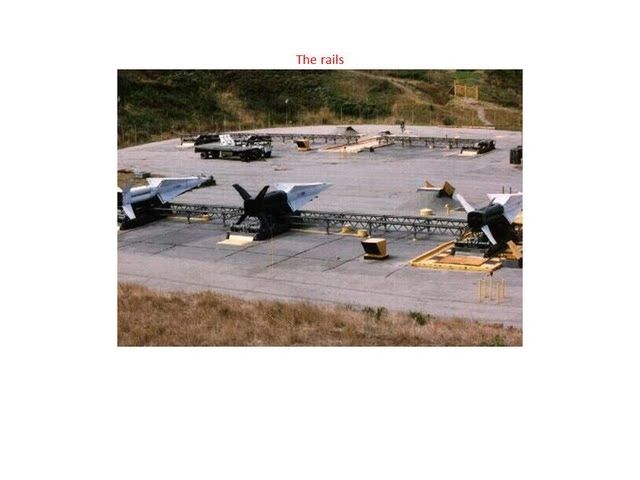

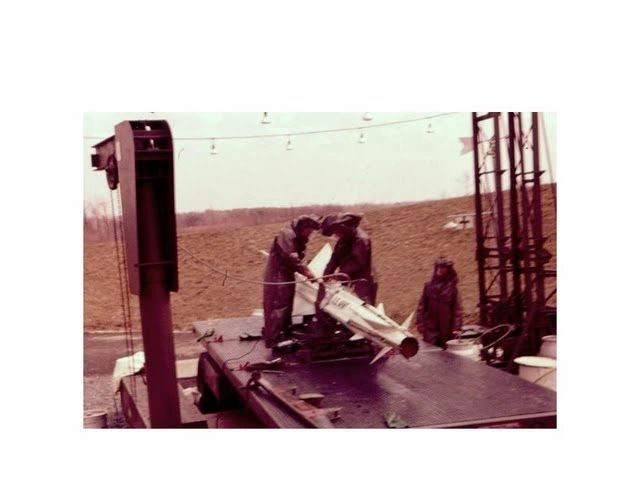




![]()






